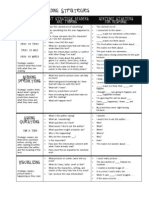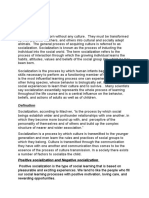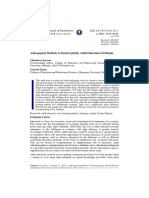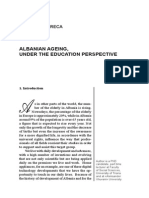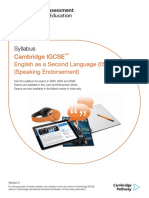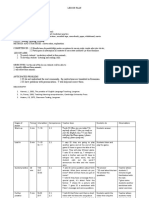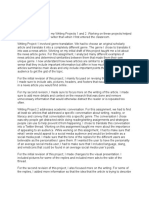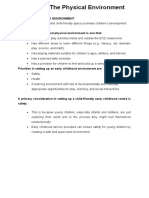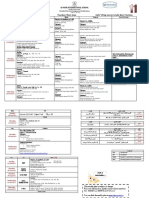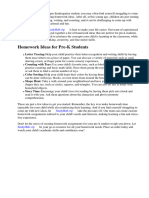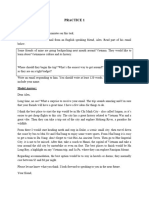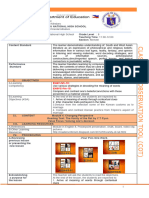100%(1)100% found this document useful (1 vote)
24 viewsFinal Ecd-1
Final Ecd-1
Uploaded by
heena ameenCopyright:
© All Rights Reserved
Available Formats
Download as PPTX, PDF, TXT or read online from Scribd
Final Ecd-1
Final Ecd-1
Uploaded by
heena ameen100%(1)100% found this document useful (1 vote)
24 views51 pagesOriginal Title
FINAL ECD-1
Copyright
© © All Rights Reserved
Available Formats
PPTX, PDF, TXT or read online from Scribd
Share this document
Did you find this document useful?
Is this content inappropriate?
Copyright:
© All Rights Reserved
Available Formats
Download as PPTX, PDF, TXT or read online from Scribd
Download as pptx, pdf, or txt
100%(1)100% found this document useful (1 vote)
24 views51 pagesFinal Ecd-1
Final Ecd-1
Uploaded by
heena ameenCopyright:
© All Rights Reserved
Available Formats
Download as PPTX, PDF, TXT or read online from Scribd
Download as pptx, pdf, or txt
You are on page 1of 51
EARLY CHILDHOOD TRAINING COURSE
1ST JULY 2024 TO 19TH JULY 2024
WEEK 1:MODULE 1
• ECE THEORIESTS
• MARIA MONTESSORI PHILOSPHY AND • Strategies for Effective Teaching in ECE
METHODS
• Child-center approach
• EYFS Area of Development
• Classroom Management Techniques
• Interest Areas in Activity Room
• CARE OF ECE ENVIRNMENT
• Introduction to competency-based education
• INTRODUCTION&IMPORTANCE OF
CBE
EPL,SENSORIAL,LANGUAGE,MATHEMATICS
• Implementing CBE in early childhood
• ECE BEHAVIOUR MANAGEMENT STRATEGIES
• Types of Learners
• Introduction to pedagogy in ECE
Friedrich Froebel 1782-1852 Maria Montessori 1870-1952 Jean Piaget’s 1896-1980
What is Maria Montessori Philosophy ?
• Respect for the Child
• The absorbent Mind
• Sensitive Period
• Prepared Environment
• Auto-Education(SELF-EDUCATION)
• Hands on Learning
• Intrinsic Motivation
• The whole child Approach
• Mixed-Age group
• Role of the Teachers
EYFS Areas of Development
INTEREST AREA
IN ACTIVITY
ROOM(EYFS)
1|SPACE TO LEARN
2|PLACES TO TALK
3|INVITATION TO EXPLORE
4|SENSORY EXPLORATION
5|PLANNING FOR INDEPENDENCE
6|CREATIVITY & PROBLEM SOLVING
7|PRAISE THE PROCESS
8|CHILD-LED LEARNING
9|INDOORS & OUTDOOR
IMPLEMENTING CBE IN EARLY
CHILDHOOD EDUCATION
TYPES OF
LEARNER
Introduction of EPL
• What is Practical?
• Meaning and Purpose of Life?
• Exercise Group
• Reason for Practical Life
• E PL division ---------care of the self
• Preliminary Exercises-------Grace and Self
• Primary Lesson
• Care of the Environment
3-Period Lesson
• 1st Period: Name
• “This is…” The teacher introduces a concept or material by naming and
demonstrating it repeatedly. Complex materials will include several
introductory lessons.
• “This is a sphere.”
• 2nd Period: Recognition
• “Show me…” The teacher may identify a concept or material and
request the child to manipulate it. This allows the child to hear the
name continuously and associates the objects visually as well.
• “Show me the sphere.”
• 3rd Period: Recall
• “What is this?”
• The teacher requests the child to identify all materials without any
assistance. When the child has mastered this period of the learning,
they may move on to more complex materials and concepts.
INTRODUCTION TO PEDAGOGY IN
ECE
CHILD CENTER APPROACH
CLASSROOM MANGEMENT
TECHNIQUES
CARE OF ECE ENVIROMENT
ECE BEHAVIOUR MANAGEMENT
STRATEGIES
WEEK 2: MODULE 2
• INTRODUCTION TO MONTESSORI EQUIPMENT
• EPL
• ACTIVITY :CREATING MONTESSORI-BASED LESSON PLAN
• JOLLY PHONIC
• Seven sets of Jolly Phonics
• BLENDING
• SEGMENTING
• DIAGRAPH
• IMPLEMENTING CBE IN ECE :CLASSROOM MANAGEMENT
INTRODUCTION TO MONTESSORI
EQUIPMENT
MATH EQUIPMENT EPL EQUIPMENT
SENSORIAL EQUIPMENT LANGUAGE EQUIPMENT
Introduction to Sensorial
• The purpose of Sensorial work
• Exercise Groups
• Sound Cylinders *Pink Tower
• Colour Tablets *Brown Stairs
• Texture Boards *Knobbed Cylinders
• Smelling Bottles
• Thermic Board
• Baric Tablets
• Geometric Solids
EXCERSISE OF PRATICAL
LIFE EPL
Introduction of Language
• The History of Language
• The Prepared Environment
• Sand paper letters *Storytelling and oral Language
• Moveable Alphabet *Grammar Symbols
• Mystery bags *Reading Classification
• Language Cards
• Phonetic Reading Books
• Writing Practice
• Sound Games
Introduction to Mathematics
• Key Components of Montessori Mathematic
• Concrete to Abstract Progression
• Self – Correction
• Sequential Learning
• Hands –on Learning *Geometry Cabinets
• Activities : Number Rods *Cards and Counter *Stamp Games
• Sandpaper Number *Golden Beads *Beads chain
• Spindle Box *Teen and Ten Boards *Fraction Insets
INTRODUCTION TO THE SOUNDS
• Jolly Phonics introduces 42 main letter sounds.
• Group 1: s,a,t,i,p,n
• Group 2: ck.e,h,r,m,d
• Group 3: g, o,u,l,f,b
• Group 4: ai,j,oa,ie,ee,or
• Group 5: z,w,ng,v,shortoo,long oo
• Group6 : y,x,ch,sh,th,(voiced),th(unvoiced )
• Group 7: qu,ou,oi,ue,er,ar
TECHNIQUES FOR BLENDING AND
SEGMENTING
TECHNIQUES FOR AND SEGMENTING
Multi –Sensory Learning
• Action *Resources
• Song and Jingles
• Flashcards
• Blending
• Segmenting
• Tricky Words
• Storybooks
• Games and Activities
Consonant Digraph
• ch: this diagraph often makes the/ch/ sound as in “chip”
• sh : produces a soft,hissing sound,e.g ship,shoes.fish
• th: the sound can be eaither voiced,or unvoiced thin, thooth
• ph: often used in words of Greek orgin,where it represent /f/e.g
graph,phone,dolphin
• wh: pronounced /w/(sometime /hw/) what,whale,when
• ck: used after short vowel in one-syllablewords e.g ,duck,cl
Vowel Diagraphs
1.ai: phoneme/ei/ e.g rain,train,mail represent long
“a”sound,commonly found in the middle of words.
2.ea: phoneme/i/e.g sea(long e)bread (short e)
3.ee: phoneme/i/e.g see,tree represent long”e”middle and end
4.ou:phonemes/au/e.g “ out,” “soul” “rough”
5.oi: phoneme/oi/ e.g coin,boil,noise,represent “oy”sound
6.ea:phonem/i/e.g beat,bread/ei/great
7.oo: phoneme/u/e.g”moon””book”
WEEK 3: MODULE 3
• Creating Inclusive Classroom Environment
• STRATEGIES FOR SUPPORTING DIVERSE
• EFFECTIVE ASSESSMENT TECHNIQUES
• CIVIC SENSE
• UNDERSTANDING SOCIAL & EMOTIONAL DEVELOPMENT
• SUPPORTING SOCIAL & EMOTIONAL GROWTH IN ECE
• WORK PLACE ATTIRE & PROFESSIONALISM
• BASIC MANNER AND COMMUNICATION WITH CHILDREN
• ENHANCING COMMUNICATION SKILLS
• INTRODUCTION OF ECD
• IMPOTANCE OF ECD
• STRATEGIES FOR EFFECTIVE ECD
UNDERSTANDING SOCIAL &
EMOTIONAL DEVELOPMENT
Self-awareness: Understanding one’s own emotions, strengths, and weaknesses.
Self-Regulation: Managing one’s emotions and behaviors effectively.
Social Awareness: Being empathetic and understanding the emotions of others.
Relationship Skills: Establishing and maintaining healthy relationships with others. Responsible
Decision-Making: Making thoughtful, ethical choices in personal and social contexts.
STRATEGIES FOR SUPPORTING DIVERSE
STRATEGIES FOR SUPPORTING DIVERSE
SUPPORTING SOCIAL & EMOTIONAL GROWTH IN
ECE
WORK PLACE ATTIRE &
PROFESSIONALISM
BASIC MANNER AND COMMUNICATION WITH CHILDREN
ENHANCING COMMUNICATION SKILLS
Creating Inclusive Classroom
Environment
BENEFITS
CIVIC SENSE
INTRODUCTION OF ECD
• Physical Development:
• Growth & Moter Skills *Health and Nutrition
• Cognitive Development:
• language & literacy,*thinking &problem-solving*learning through play
• Emotional –Concept:
• Self-Regulation*Self-Concept*Emotional Expression
• Social Development:
• Social Skills*Relationship* Community Involement*
• Educational Environment:
• safe &nurturing Environment*qualified Educators
Importance of ECD
• Foundation for Future Learning
• Economics Benefits
• Social Equity
• Strategies for Effective ECD
• Parental Involvement
• Integrated Services
• Policy and Advocacy
You might also like
- Mccarthy Michael Et Al Touchstone 4 Teacher S Book PDFDocument253 pagesMccarthy Michael Et Al Touchstone 4 Teacher S Book PDFDain Mun76% (37)
- Language Disorders: A Functional Approach To Assessment and Intervention (The Allyn & Bacon Communication Sciences and Disorders)Document23 pagesLanguage Disorders: A Functional Approach To Assessment and Intervention (The Allyn & Bacon Communication Sciences and Disorders)amandiemarneyz100% (15)
- The Magic of Reading by Bill HillDocument70 pagesThe Magic of Reading by Bill Hillannafaraday100% (2)
- Cognitive Reading Strategies With StartersDocument2 pagesCognitive Reading Strategies With Starterseva.benson100% (2)
- SocialisationDocument34 pagesSocialisationDzihlornu Precious100% (2)
- EDU301Document10 pagesEDU301Carly Notley100% (1)
- Action Plan For Reading Prog.Document6 pagesAction Plan For Reading Prog.Princess Canceran Bulan92% (13)
- African Indigenous EducationDocument15 pagesAfrican Indigenous EducationJustus OjiamboNo ratings yet
- Danish Youth WorkDocument18 pagesDanish Youth Workapi-554605230No ratings yet
- Edu 144 Portfolio Case Study ObservationsDocument10 pagesEdu 144 Portfolio Case Study Observationsapi-249260151No ratings yet
- Strategies For Teachers Working With Students With Orthopedic ImpairmentsDocument4 pagesStrategies For Teachers Working With Students With Orthopedic Impairmentsapi-268598032100% (2)
- Module 1Document11 pagesModule 1ZONETTE PAREDO100% (1)
- The Open University of Tanzania Faculty of Education Programme Specification Certificate in Early Childhood Care and Education CecceDocument19 pagesThe Open University of Tanzania Faculty of Education Programme Specification Certificate in Early Childhood Care and Education CecceaminaNo ratings yet
- Early Childhood Education2Document15 pagesEarly Childhood Education2Sharanjeet SinghNo ratings yet
- Ece 113 - 0Document97 pagesEce 113 - 0neetusingh242001No ratings yet
- EDUC 60 Module 5 The School As An Agent of Change M.MilesDocument39 pagesEDUC 60 Module 5 The School As An Agent of Change M.MilesRosever HernandezNo ratings yet
- Social Institutions: Muhammad Abdullah (SSP15 CE10) Abdul Rehman Khan (SSP15 CE25)Document11 pagesSocial Institutions: Muhammad Abdullah (SSP15 CE10) Abdul Rehman Khan (SSP15 CE25)Abdul Rehman Khan100% (2)
- Notes On Topic 3 Classical Theories of Social StratificationDocument13 pagesNotes On Topic 3 Classical Theories of Social Stratificationkathir100% (1)
- Social Institutions Rural ReportDocument36 pagesSocial Institutions Rural ReportVitas Vitaly100% (1)
- Cultural DiversityDocument4 pagesCultural Diversitymina villamor100% (1)
- EDU112-Traditional African Education-EDU UNILORIN-2020-141Document12 pagesEDU112-Traditional African Education-EDU UNILORIN-2020-141Abolaji Abdulrahman AlabiNo ratings yet
- An Assignment On: Submitted by Submitted ToDocument6 pagesAn Assignment On: Submitted by Submitted ToMahabur RahmanNo ratings yet
- Edfd 227 Question 4 s00142914Document8 pagesEdfd 227 Question 4 s00142914api-254146673No ratings yet
- Social Movements and Its Impact BDocument6 pagesSocial Movements and Its Impact BAngelica EstipularNo ratings yet
- Css111 Introduction To SociologyDocument114 pagesCss111 Introduction To Sociology2johnnysmith201100% (1)
- 2.4 - Types of Early Childhood EducationDocument4 pages2.4 - Types of Early Childhood EducationAnum IqbalNo ratings yet
- Social Stratification Zimsec NotesDocument132 pagesSocial Stratification Zimsec NotesLucyNo ratings yet
- 891566643180unit-10 - Extension Management and Community DevelopmentDocument8 pages891566643180unit-10 - Extension Management and Community DevelopmentGaganpreet Kaur Fashion Designing100% (1)
- Chapter1 Lesson-2Document5 pagesChapter1 Lesson-2Domi NyxNo ratings yet
- Modernization and Westernization ThoughtsDocument4 pagesModernization and Westernization ThoughtsV B100% (1)
- Lecture Notes 7 - SocializationDocument3 pagesLecture Notes 7 - Socializationpowerdgnflag100% (1)
- Introduction To SociologyDocument21 pagesIntroduction To SociologyRana Diyan100% (1)
- Social Change and Education: Haqiqat Ali Nift-Hyderabad 9/20/2012Document15 pagesSocial Change and Education: Haqiqat Ali Nift-Hyderabad 9/20/2012Haqiqat Ali100% (2)
- Early Childhood Education Research Paper TopicsDocument6 pagesEarly Childhood Education Research Paper Topicsfvdh47rr100% (1)
- Social StratificationDocument9 pagesSocial StratificationDark SevenNo ratings yet
- Introduction To SociologyDocument4 pagesIntroduction To Sociologyasad khanNo ratings yet
- Research Methodology: Dology - HTMLDocument7 pagesResearch Methodology: Dology - HTMLMay Angelica TenezaNo ratings yet
- Community Organization 1Document172 pagesCommunity Organization 1androos achayanNo ratings yet
- Day 3 - Social Change - in DepthDocument36 pagesDay 3 - Social Change - in DepthFfrekgtreh Fygkohk100% (1)
- Socialization: ConceptDocument3 pagesSocialization: ConceptSumit MalaanNo ratings yet
- Data CollectionDocument39 pagesData CollectionJulie TrinidadNo ratings yet
- G4 Module 6Document24 pagesG4 Module 6Kimberly ManguerraNo ratings yet
- Socialisation Notes 2021 DSWDocument9 pagesSocialisation Notes 2021 DSWLeigh-Ann T DhliwayoNo ratings yet
- Sociology and Common SenseDocument1 pageSociology and Common SenseSAMADHAN KAKADE100% (1)
- Andragogical ApproachDocument16 pagesAndragogical ApproachGarkebo BashaNo ratings yet
- Social Change and EducationDocument4 pagesSocial Change and EducationIzna100% (1)
- Module 2 School As A Social SystemDocument5 pagesModule 2 School As A Social SystemREGIE PALASINo ratings yet
- Deviance and Social ControlDocument28 pagesDeviance and Social ControlJyoti Yadav100% (1)
- See Judge Act2Document6 pagesSee Judge Act2Alyssa CruzNo ratings yet
- Society - Culture, Race and Ethnicity 2015-16Document32 pagesSociety - Culture, Race and Ethnicity 2015-16Nalini RooplalNo ratings yet
- Social Stratification PowerpointDocument56 pagesSocial Stratification Powerpointninety-nine100% (1)
- 11: Social Development: Student ObjectivesDocument10 pages11: Social Development: Student ObjectivesŞterbeţ RuxandraNo ratings yet
- Sociology and Common Sense-Converted - 091318Document9 pagesSociology and Common Sense-Converted - 091318SumeshAkhyaiNo ratings yet
- BCT582 Module 2 Research Methodology (Part 2)Document19 pagesBCT582 Module 2 Research Methodology (Part 2)sharifah atiqahNo ratings yet
- Culture and IdeologyDocument19 pagesCulture and IdeologyrenNo ratings yet
- Contemporary Trends and Developments in Early Childhood Education inDocument11 pagesContemporary Trends and Developments in Early Childhood Education inRatna DewiNo ratings yet
- Guidance and CounsellingDocument45 pagesGuidance and CounsellingPraveena LogeswaranNo ratings yet
- Eris DHAMO GRECA ALBANIAN AGEING, UNDER THE EDUCATION PERSPECTIVEDocument16 pagesEris DHAMO GRECA ALBANIAN AGEING, UNDER THE EDUCATION PERSPECTIVECentre for Regional Policy Research and Cooperation Studiorum100% (1)
- FREUDs Stages of Psychosexual DevelopmentDocument3 pagesFREUDs Stages of Psychosexual DevelopmentKymm Andrea GeveroNo ratings yet
- The Study of Marital Adjustment in EmployersDocument13 pagesThe Study of Marital Adjustment in EmployersPrecious UdoadaNo ratings yet
- Gender Roles and SocializationDocument6 pagesGender Roles and SocializationJenny May GodallaNo ratings yet
- Sociology of Education Notes 2021Document41 pagesSociology of Education Notes 2021ntaate denis100% (1)
- Conformity and Social InfluenceDocument4 pagesConformity and Social Influenceअभिनव कृष्णNo ratings yet
- Erikson - S Psychosocial TheoryDocument16 pagesErikson - S Psychosocial TheoryAnkit guptaNo ratings yet
- Bsw3703 Presentation Notes 3 - Community Work PrinciplesDocument12 pagesBsw3703 Presentation Notes 3 - Community Work Principlesronel barnard100% (1)
- Theater Royal Plymouth: Booking FormDocument12 pagesTheater Royal Plymouth: Booking FormVõ HằngNo ratings yet
- Dual Purpose Experiences - Presentation - MWitterDocument11 pagesDual Purpose Experiences - Presentation - MWitterKIPPNYCDocs100% (2)
- Cianciolo, Patricia J. - Informational Picture Books For Children-American Library Association (2000)Document215 pagesCianciolo, Patricia J. - Informational Picture Books For Children-American Library Association (2000)Greta GamondesNo ratings yet
- Syllabus: Cambridge IGCSE English As A Second Language (0510) (Speaking Endorsement)Document33 pagesSyllabus: Cambridge IGCSE English As A Second Language (0510) (Speaking Endorsement)Eiman MounirNo ratings yet
- Public Administration 2012 13Document102 pagesPublic Administration 2012 13ALI SABARNo ratings yet
- Classroom Observatoin Tool 08.10.2020Document15 pagesClassroom Observatoin Tool 08.10.2020Maha shahNo ratings yet
- Lecture Unit 4 Module 2Document16 pagesLecture Unit 4 Module 2del420No ratings yet
- Assessment Tools ClaveriaDocument3 pagesAssessment Tools Claveriamariobaluyut0706No ratings yet
- Inspectie 3 Plan IleanaDocument3 pagesInspectie 3 Plan IleanaAna Maria TincescuNo ratings yet
- Reading Explorer 3E - Level 2 - CEFR CorrelationDocument104 pagesReading Explorer 3E - Level 2 - CEFR CorrelationyylamNo ratings yet
- Reflective LetterDocument2 pagesReflective Letterapi-643132724No ratings yet
- CELT S Module 2 TaskDocument1 pageCELT S Module 2 TaskMarwa Diab100% (1)
- Chapter 1Document46 pagesChapter 1ZiziNo ratings yet
- Akaisha Kaur X A - READING SKILLS - COMPREHENSIONDocument3 pagesAkaisha Kaur X A - READING SKILLS - COMPREHENSIONSatinder Pal SinghNo ratings yet
- Grade 2 Boys - 7444951 - 124 - 2082092140 PDFDocument10 pagesGrade 2 Boys - 7444951 - 124 - 2082092140 PDFAbdelfattahHabibNo ratings yet
- Dokumen Penjajaran Kurikulum Bahasa Inggeris Tingkatan 2 KSSMDocument7 pagesDokumen Penjajaran Kurikulum Bahasa Inggeris Tingkatan 2 KSSMQhairunisa HinsanNo ratings yet
- Homework Ideas For Pre KDocument7 pagesHomework Ideas For Pre Kzacqqrilf100% (1)
- Specific Learning DisabilityDocument67 pagesSpecific Learning DisabilityKRISHNA VASAN100% (3)
- Explorations in Language Acquisition and Use: The Taipei Lectures by Stephen D. KrashenDocument22 pagesExplorations in Language Acquisition and Use: The Taipei Lectures by Stephen D. KrashenGuy Colvin67% (3)
- 30 Đề Mẫu Writing VstepDocument65 pages30 Đề Mẫu Writing Vstepannietxun24No ratings yet
- The Wolf and The Crane 11Document7 pagesThe Wolf and The Crane 11Donnette Davis100% (4)
- Debate On The Topic Homework Should Be BannedDocument7 pagesDebate On The Topic Homework Should Be Bannedcjawq9cd100% (1)
- Sanisa Latifah - Thesis Analysis RPWDocument3 pagesSanisa Latifah - Thesis Analysis RPWvn rynNo ratings yet
- LP English The Vanity of The Rat - FinaldocDocument5 pagesLP English The Vanity of The Rat - FinaldocJohn Mark MangiNo ratings yet




